“Moments” is a fun, interactive new museum experience concept designed for the University of Sydney's new Chau Chak Wing Museum which opens in 2019. This new experience will facilitate a more meaningful way of communication between visitors, and make the museum a much more dynamic learning environment/hub, where visitors can be filled with new-found insights of themselves and their surroundings, have an inspirational experience and have such an amazing visitor experience that they are eager to come visit the museum again soon.
Moments
CLASS: DECo2014 user experience design studio
DATES: march TO june 2017
LOCATION: THE UNIVERSITY OF SYDNEY, SYDNEY
MY ROLE: USER RESEARCH/DOCUMENTATION LEAD
MY TEAM: DANIEL CHAN, adrian wong
MY TUTOR: daWEI ZHOU
Introduction
As part of DECO2014 User Experience Design Studio, and in collaboration with the University of Sydney’s new Chau Chak Wing Museum, the semester’s project was focused on designing a digital/tangible/spatial experience for the new museum that:
Improves the visitor experience
Fulfils the educational goals of the institution
Helps the museum engage with new audiences (or affirm their relationship with existing ones)
Our Design Process
User Research
In groups, we began by creating a direct experience storyboard of one of the existing museums at our University, and observed peoples’ movements and behaviour in the museum. Following this we did some background research on museums in general and found out that from 2008-2012, the largest decrease in museum attendance was of a younger demographic, between 18-24 years old. After some consideration, we decided to focus our target audience on this age bracket to come up with some new digital/tangible/spatial experiences that will hopefully bring back and engage this demographic in the new museum, and museums in general.
Following this initial research, we devised a research plan where we came up with our research objectives, concrete research questions and research methods we would use.
Research Questions:
Why has the appeal for museums been lost over the past 10 years?
What kinds of people still enjoy going to museums?
What characteristics of museums cause people to lose an interest?
What could a museum implement to improve their experience for customers?
Research Objectives (what we hope to learn from our research):
Why don’t people like going to museums?
What attracts people that do like going to museums?
How can we increase the appeal of a museum by adding modern qualities
We decided to apply the context mapping research technique through a bottom-up approach, where we were able to first start learning of the explicit and observable needs of our participants then later start honing into the more implicit and latent needs in regards to our research objectives.
The way we approached the sensitising process was that we wanted to make the participant/user think about ‘why they haven’t done something’. For example, why haven’t they gone to a museum often, or why don’t they have an interest in museums. By doing so, we received better answers thus the data is more valuable, mainly because the reality of museums is that there are more people that do not like it than people that do.
We distributed a sensitising booklet to ten participants who were within our target audience of 18-24 years old, and had been to a physical/online museum at least once in the past year, a few days prior to our two generative sessions. The goal of this sensitising booklet was to prepare them for our generative sessions.
Our first generative session was conducted at an outside cafe in a less busy part of the University, which was quiet but also allowed us to converse with our participants (unlike the library where talking is not encouraged). By conducting the session outside, participants were able to feel more comfortable, and have the option to get food and drinks if they wished. Also, the environment was informal, adding to the sense of informality and making the session less intimidating and more comforting for the participants. Our second generative session was conducted indoors, in a quiet living room at a student accomodation building in the evening.
The generative sessions involved us finding out the reasons for the answers to why they may or may not have an interest in museums, through a moderated and guided two part phase. Firstly, we had a Then/Now/Like/Dislike framework to find out how users feel about museums now, and how they felt about them, before answering our first research question, “Why has the appeal for museums lost over the past 10 years?”. As the participants finish each respective phase, questions were asked about their responses to attain further detail.
Questions asked included:
How long since you’ve visited a museum, whether it be online or physical?
Did you enjoy the experience?
Why did you go to the museum?
Do you normally go to museums with people? How do you relate to these people?
If you could rate your experience out of ten, where would you put it?
Were there any aspects of the museum that you did not enjoy?
Could the museums do anything to make your experience more enjoyable?
How long did you stay at the museum for?

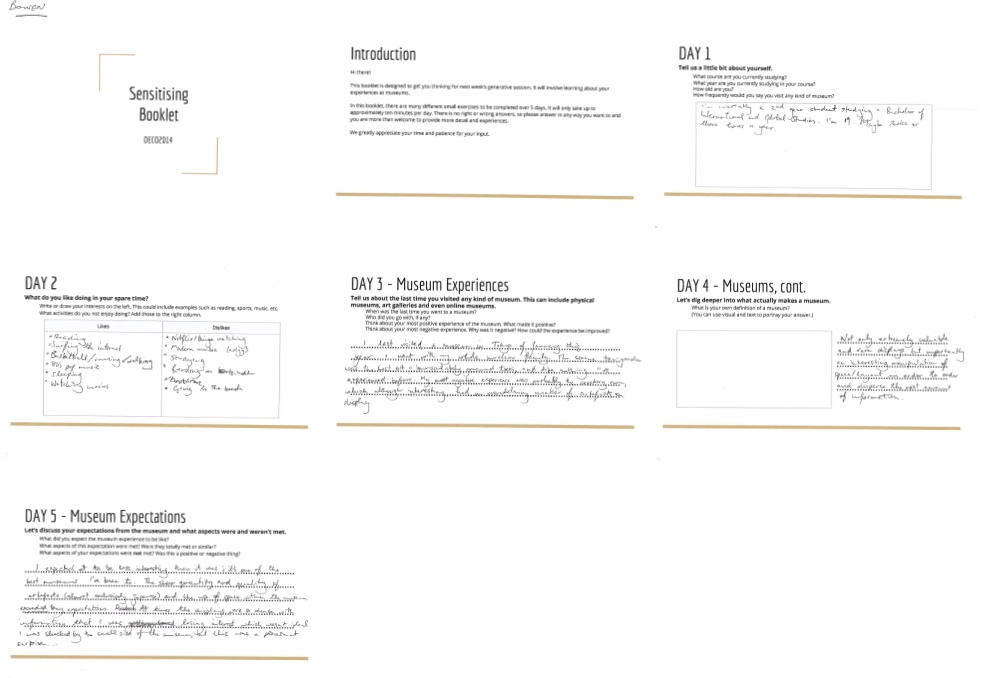
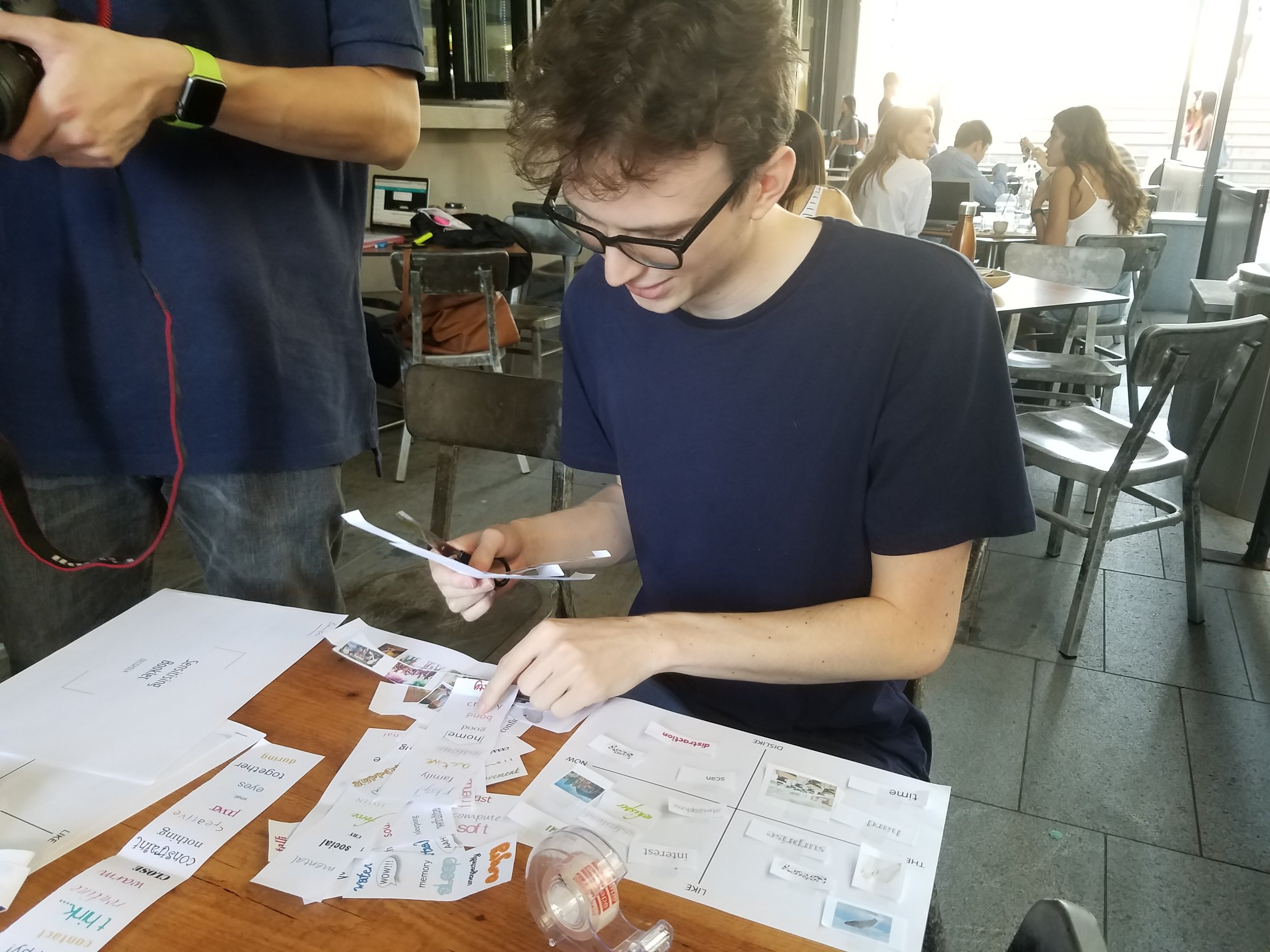



Following our generative sessions, I worked on transcribing only the data relevant to answering our project research objective - namely why people don’t like going to museums anymore. From this I worked with my team to identify trends within the data.
To prepare for a group data analysis session, each of us created our own statement cards using our newfound trends from our data - which we colour coded - and added our thoughts to them. During the session with my group, we identified the reasons behind why people don’t like going to museums anymore, what features attracted them to certain parts of museums, and ways that could possibly increase the appeal of museums to a younger audience. We discussed our thoughts and insights from this data and created an affinity diagram and came to a conclusion of our research objectives. We want to make people FORGET that they are in a museum by adding:
More interactivity
Allow photography/selfies → we found that users want to SHARE their experiences
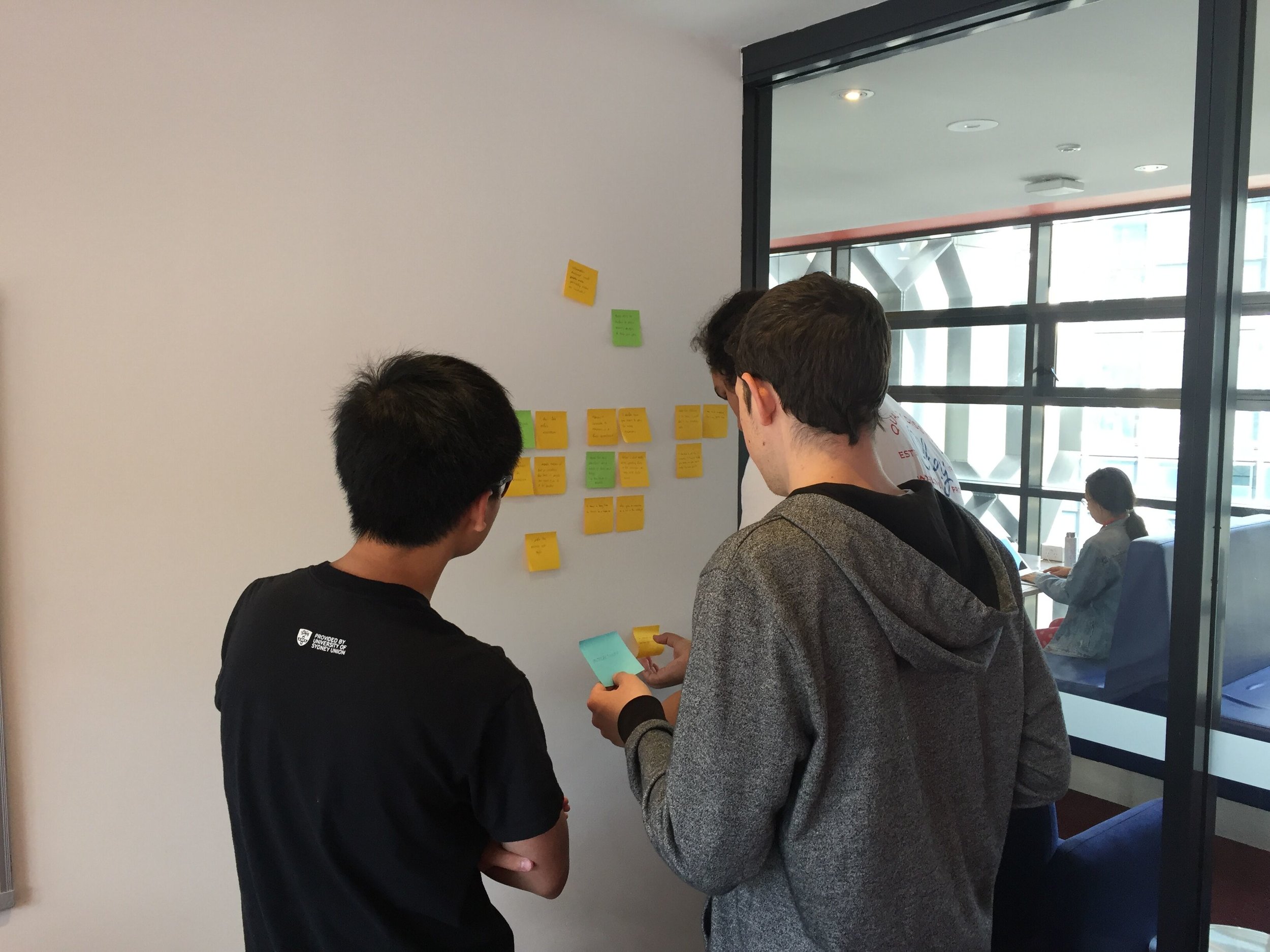
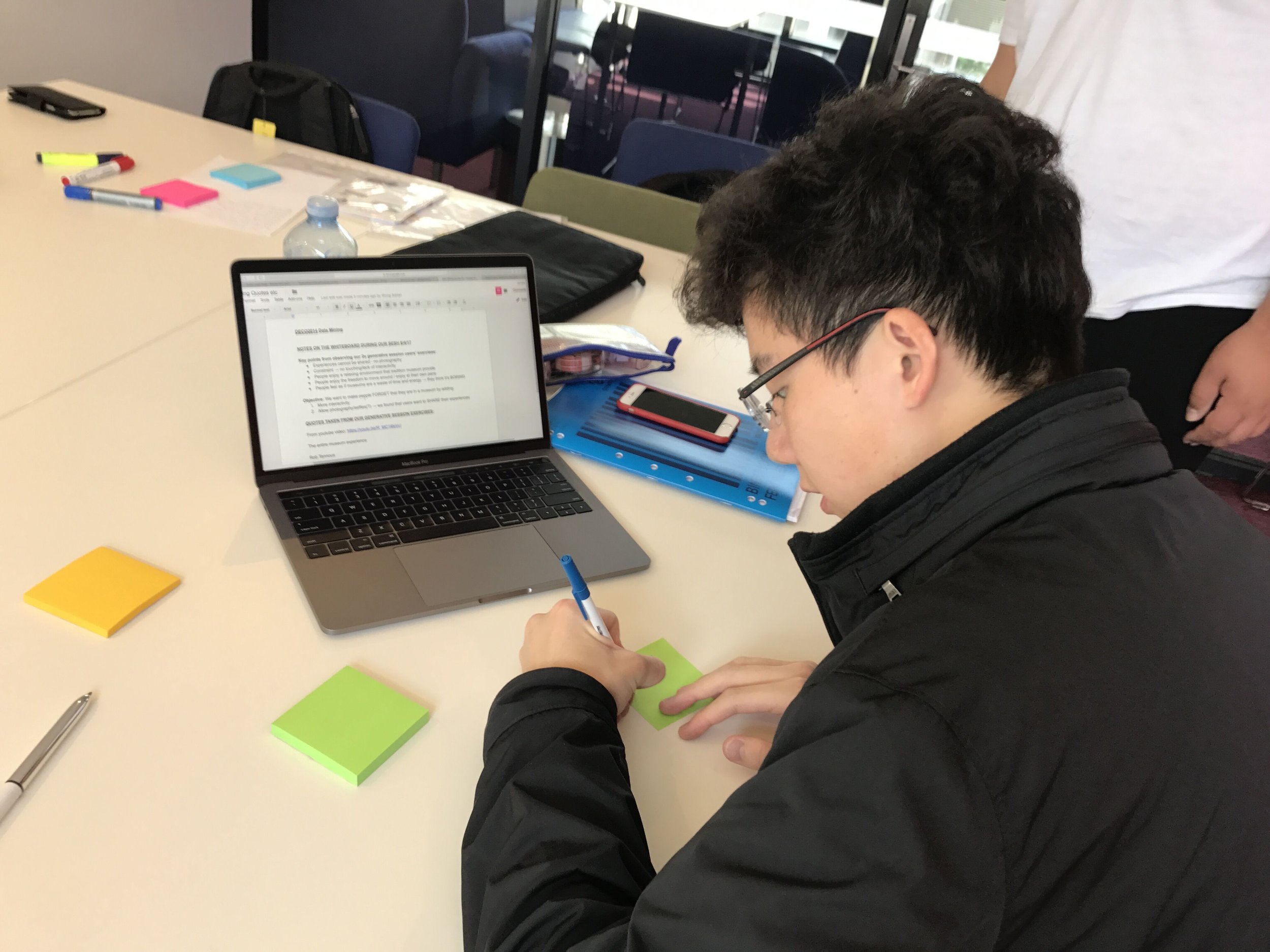


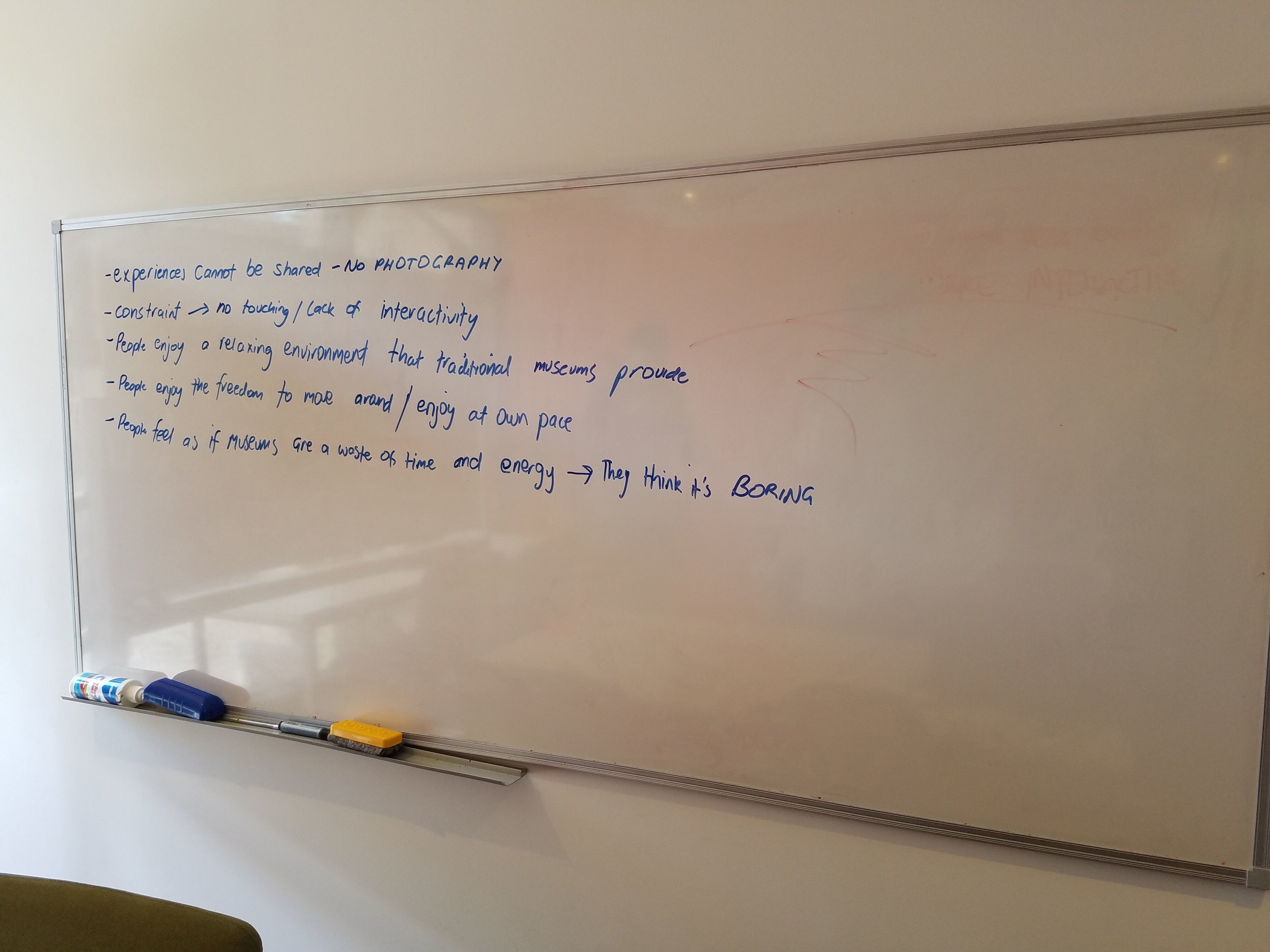
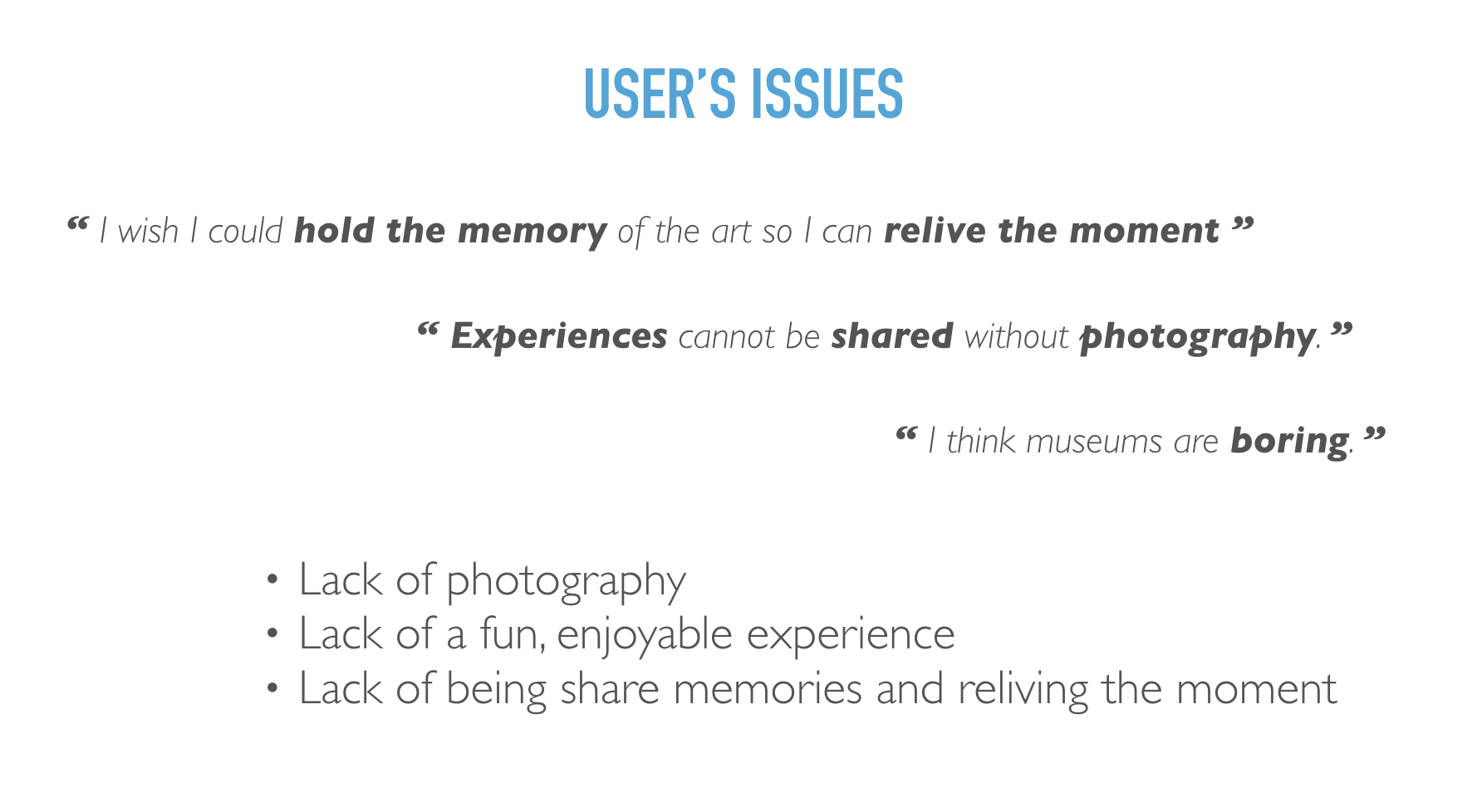
(Modified) Design Brief
Following conducting background research and user research with our target audience - university students, my group and I formulated our own modified Design Brief that we aimed to solve:
Concept Exploration and the Decision Making Process
I began rapidly ideating a number of concepts before narrowing in on two initial concepts that addressed the users’ needs. I then refined and visualised these concepts with the use of storyboards and images.
Concept 1: “Moments”
From the moment a visitor walks through the museum entrance (free of charge), they are greeted with a large collage of digital screens (of different sizes), that contain visitor’s thoughts, ideas and experiences that are updated in real time - like a live feed in visual form. Visitors have the chance to add to this conversational-like wall by using touchscreen tablets, which are placed in selected locations in each exhibit, where they can take selfies, become emoji-fied, add comments and share ideas with other visitors and the museum - and let’s not forget they can share these with their friends and family and social media! These digital screen installations encompass of spatial elements in that they use body tracking sensors that attract nearby visitors.
The use of ‘Moments’ will hopefully create more meaningful conversations between visitors in the museum and make the museum a much more dynamic learning environment/hub as envisioned in our vision statement, where they can be filled with new-found insights of themselves and their surroundings, have an inspirational experience and have such an amazing visitor experience that they are eager to come visit the museum again soon.
Concept 2: “Memories”
From Assessment 2, we envisioned a more dynamic learning environment where visitors will forget about time - something they indeed complained about, where they can learn something new and feel a sense of accomplishment after the visit.
‘Memories’ answers this user’s need by providing an innovative museum experience with a small reward for learning aimed at young people especially, and help ‘bridge-the-gap’ between this age group and museums. Visitors will gain as much knowledge as possible in each exhibit - reading and learning about the artworks as much as they can, then answer a randomised series of questions on an interactive display (iPad). If they get 100% in each of the exhibit quizzes, they will receive a prize - a collectable 3D printed model of their favourite art piece in the museum - a ‘Memory’ that they can bring home, and hence feel a sense of accomplishment when leaving and looking back on their museum experience.
After pitching my concepts to suitable users, stakeholders and tutors, it became clearer to myself which concept stood out more and what I could do to improve the concepts.
Following this, my group member and myself used a Design Pugh Matrix and an accompanying rationale to help us come to a decision to which concept we should further work on.
In our rationale, I mentioned that with the criteria we used to test my group’s concepts, my concept “Moments” best responds to user needs and our vision statement, and was to be the concept we as a team would further maturate.
The Final Concept - “Moments”
“Moments” is a fun, interactive new museum experience concept designed for the University of Sydney's new Chau Chak Wing Museum which opens in 2019. Featuring three technologies feasible today - QR Codes, Facial Recognition, and large LCD screens, “Moments” aims to bridge the gap between our target audience - Uni Students and museums. “Moments” was based on our Design Brief which we formulated after immense user research - to improve 'the way visitors in groups are able to communicate to each other without causing too much racket for other groups yet have a fun, memorable experience.'
From the moment a visitor walks through the museum entrance, they are given an iPad, which is loaded with a special Chau Chak museum app. As they walk through the museum, they can scan QR codes next to each artwork, which loads artwork-specific unique filters and banners onto the app. Visitors now have the option to create 'Moments' - take selfies and photos using these filters and banners, become emoji-fied using their favourite emoji characters, add comments, and share ideas with other visitors and the museum to add to the large conversational-like Digital Wall in the final room of the museum, and let’s not forget they can share these with their friends and family and social media! In the final room of the museum they are greeted with a large collage of digital screens (of different sizes) - a Digital Wall, that contains these 'Moments' that are updated in real time - like a live feed in visual form.
“Moments” will hopefully facilitate a new more meaningful way of communication between visitors, and make the museum a much more dynamic learning environment/hub as envisioned in our vision statement, where visitors can be filled with new-found insights of themselves and their surroundings, have an inspirational experience and have such an amazing visitor experience that they are eager to come visit the museum again soon.








